Vedesa Tirtha
Vedesa Tirtha (c. 1570 - c. 1620) (also known as Vedesa Bhiksu), was an Indian Hindu scholar and theologian in the Dvaita Vedānta tradition. He was the disciple of Raghuttama Tirtha and Vedavyasa Tirtha, and is the most celebrated name in the annals of the Dvaita Vedanta. He is a Bidi-Sanyasi (stray ascetic) and not pontiff of any mutt.[1]
Vedesa Tirtha | |
|---|---|
| Personal | |
| Born | 1570 |
| Died | 1620 Mannur |
| Religion | Hinduism |
| Philosophy | Dvaita Vedanta |
| Religious career | |
| Guru | Raghuttama Tirtha |
Disciples
| |
| Part of a series on |
| Dvaita |
|---|
 |
|
Literature
|
|
|
Holy places |
| Hinduism portal |
Works
Vedesa Bhiksu composed ten major works, most of them are commentaries and glosses on the works of Madhva and Jayatirtha.[1][2][3][4][5]
- Tattvoddyota Panchika - a gloss on Tattvoddyota of Madhva
- Pramāṇalakṣaṇaṭikā Vyakhyana - a gloss on Pramāṇalakṣaṇaṭikā of Jayatirtha
- Viṣṇutattvanirṇayaṭikā Vyakhyana - a gloss on Viṣṇutattvanirṇayaṭikā of Jayatirtha
- Kathālakṣaṇavivarana Vyakhyana - a gloss on Kathālakṣaṇavivarana of Jayatirtha.
- Karmaṅirṅayaṭikā Vyakhyana - a gloss on Karmaṅirṅayaṭikā of Jayatirtha.
- Aitareya Upanishad Bhashya - a commentary on Aitareya Upanishad Bhashya of Madhva
- Chandogya Upanishad Bhashya - a commentary on Chandogya Upanishad Bhashya of Madhva
- Katha Upanishad Bhashya - a commentary on Katha Upanishad Bhashya of Madhva
- Talabavara tippani - a commentary on Kena Upanishad Bhashya of Madhva.
- Pramāṇapaddhatī Vyakhyana - a gloss on Pramāṇapaddhatī of Jayatirtha
Brindavana
His tomb is at Manur on the bank of Bhima river, which was a center of learning right from the days of predecessors of Raghuttama Tirtha himself.[1]
gollark: Welcome, inevitable visitor.
gollark: <@231856503756161025> Remy must obey normal quarantine protocols.
gollark: It has some sort of trainable thing? Interesting. Just Markov chains?
gollark: <@734140198236979302> <@160279332454006795> <@734140198236979302> <@160279332454006795> <@734140198236979302> <@160279332454006795> <@734140198236979302> <@160279332454006795> <@734140198236979302> <@160279332454006795> <@734140198236979302> <@160279332454006795> <@734140198236979302> <@160279332454006795> <@734140198236979302> <@160279332454006795> <@734140198236979302> <@160279332454006795> <@734140198236979302> <@160279332454006795> <@734140198236979302> <@160279332454006795> <@734140198236979302> <@160279332454006795> <@734140198236979302> <@160279332454006795> <@734140198236979302> <@160279332454006795> <@734140198236979302> <@160279332454006795> <@734140198236979302> <@160279332454006795> <@734140198236979302> <@160279332454006795> <@734140198236979302> <@160279332454006795> <@734140198236979302> <@160279332454006795> <@734140198236979302> <@160279332454006795>
gollark: BEE!
References
- Sharma 2000, p. 492.
- Sharma 2000, p. 493.
- Dasgupta 1975, p. 90.
- White 2004, p. 20.
- Potter 1995, p. 1486.
Bibliography
- Sharma, B. N. Krishnamurti (2000). A History of the Dvaita School of Vedānta and Its Literature, Vol 1. 3rd Edition. Motilal Banarsidass (2008 Reprint). ISBN 978-8120815759.CS1 maint: ref=harv (link)
- Potter, Karl H. (1995). Encyclopedia of Indian philosophies. 1, Bibliography : Section 1, Volumes 1-2. Motilal Banarsidass Publications. ISBN 978-8120803084.CS1 maint: ref=harv (link)
- Dasgupta, Surendranath (1975). A History of Indian Philosophy, Volume 4. Motilal Banarsidass. ISBN 978-8120804159.CS1 maint: ref=harv (link)
- White, Charles S. J. (2004), A Catalogue of Vaiṣṇava Literature on Microfilms in the Adyar Library, The Bodleian Library & The American University Library, Motilal Banarsidass Publications, ISBN 978-8120820678CS1 maint: ref=harv (link)
This article is issued from Wikipedia. The text is licensed under Creative Commons - Attribution - Sharealike. Additional terms may apply for the media files.